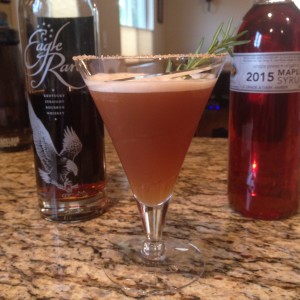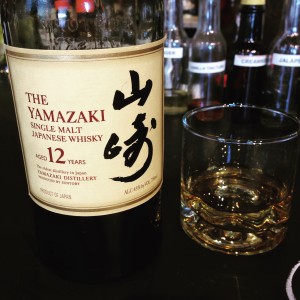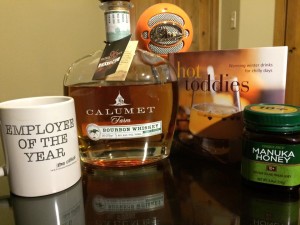Nov 5, 2015: From mulling wine to whisk(e)y wisdom Steph & Val offer up some fun information on hot mug classics. We also touch on basic types of whiskies. Or is it whiskeys? Both are correct, as you’ll see. So get ready to snuggle up, wrap your hands around a big ol’ mug of happiness, and join us for another tasty episode as we give you the 411 on warm cocktails and favored fortifications. *Note: we talked about blended Scotch Whisky also being called “vatted” whisky; you won’t see that word on bottles after 2011.
We were practically “Bourbon Soul Sisters” in this episode as Steph had her hands wrapped around a hot toddy with Bourbon whisky and Val sipped a warm apple cider Bourbon cocktail with maple syrup. We should add that none of this was planned.
This week we wanted to heat up November and brighten up those shorter, darker days with warm boozy beverages since it’s hot toddy & mulled wine season. Back to what we mentioned about warming-up your hands with a hot beverage, these drinks are also appealing for their aromatic pleasure. Part of the indulgence is bringing the warm drink closer to your nose and inhaling all the various smells – could be something new that you’ve never smelled before or could bring you straight back to a special memory.

Warm apple cider Bourbon cocktail, shaken, not stirred. The rosemary adds to the sensory experience.
Steph broke out her petite, fun book called Hot Toddies – Warm WInter Drinks for Chilly Days. According to the book, the traditional Hot Toddy is made with whiskey, lemon juice, honey (or simple syrup), hot water and a lemon pierced with cloves. (We couldn’t find this book online, but we found some other ones and linked them up in our W25 store!)
A Hot Buttered Rum, on the other hand, is very similar but is made with dark rum and a tablespoon of unsalted butter. One of the coolest things about these hot drinks is that you’re likely to have most of the ingredients, if not all, on hand.
Now, mulled wine for #W25 listeners, this is a great entertaining drink that you can make is a large batch before people come over. Simmer two bottles of fruity red wine on the stove with oranges, cloves, brown sugar, fresh ginger, a cinnamon stick and nutmeg.
There are endless variations to mulled wine, so get creative and try different spices, maybe add a dash of Cointreau.
Don’t forget this last detail – do not serve in a wine glass. This is a hot drink, so make sure to ladle into mugs or heatproof glasses. (Val’s was only warmed up slightly, so not served hot, hence the fancy schmancy vintage glassware, although for the show she had a mug that was preheated and served with the same cocktail, just somewhat warmer).
There are also a few drink recipes in this Hot Toddy book that are lit on fire. That sounds fun but dangerous. Probably want to make that drink first.
A few rules to help you out:
When it comes to hot beverages with alcohol, always pre-warm your mug by filling it with boiling water.
Secondly, don’t use something so expensive and unique since the flavours & qualities may not be fully enjoyed; remember, you are adding also some hot tea or water, a little sugar or honey, and a lemon twist to about 1 or 2 ounces of your favorite brown spirit.
Breaking down the booze behind the beverages:
While the hot toddy is believed to have originated in Scotland in the 17th century, it’s something we all grew up believing was the cure to whatever is trying to take you down, physically or otherwise.
Typically used:
Scotch Whisky: Can only be distilled and aged in Scotland, min 3 years in wood of max 700L capacity. There are also different types of Scotch that you may see on the shelves:
Single Malt Scotch Whisky: the “single” just means all the spirits in this bottle come from a single distillery, but could be a blend of different casks of malted barley.
Single Grain Scotch Whisky: contains some malted barley + malted/unmalted grains, again, from a single distillery
Blended Malt Scotch Whisky: This will have two or more single malt scotch whiskies, different distilleries. *If you see the words “Vatted Malt Scotch Whisky” then it was bottled before 2011, but it means “blended” malt Scotch Whisky.
Blended Grain Scotch Whisky: This is a blend of at least two single grain scotch whiskies, but from different distilleries
Blended Scotch Whisky: This is most of what you see on the market and about 90% of the export; it contains a blend of at least one grain and one malt whisky.
Other kinds of whisk(e)y:
Bourbon Whiskey: Can be made anywhere in the US, 95% is made in Kentucky. It must be 51% corn, aged at least 2 yrs in NEW charred barrels, usually American white oak.
Irish Whiskey: Must be made and aged in Ireland, also at least 3 years maturation in oak.
Rye: American Rye must be 51% rye, aged in charred new oak barrels for at least 3 years.
(Canadians also make rye & corn based whiskies).
Straight Whisky: in the US aged at least 2 years, barrels must be charred, new oak, no added coloring or flavours. 51% min of corn (Bourbon or Tennessee) plus rye, wheat, malt, etc.
Tennessee Whiskey: is made like bourbon, same requirements and since May 2014 the Lincoln county Process (maple charcoal filtering) is required except for one distiller, Benjamin Prichard, who never used it.
Whiskey vs Whisky Irish = Whiskey; Irish immigrants brought their whiskey to the US, so we usually use the ‘e.’
The Scots translated the Gaelic form without the ‘e’. Since Japan models their whiskies after Scotch, they, too, spell it Whisky. Since in the 19th century Scotch didn’t have the best reputation but was being exported anyway, the Irish wanted to make sure their quality product was not being confused with something perceived as  more inferior. Hence, the extra e stayed as a rule to distinguish Irish Whiskey from Scotch Whisky. Canada also spells it without the ‘e.’
more inferior. Hence, the extra e stayed as a rule to distinguish Irish Whiskey from Scotch Whisky. Canada also spells it without the ‘e.’
So here’s the deal on the ‘e.’ If the country the spirit was made in has an ‘e’ in the name (Ireland, United States, then so does the word whiskey. The plural would then be “whiskeys”.) Countries without ‘e’s in their names (Canada, Scotland, and Japan) spell it whisky (plural whiskies).
Another topic that came up was that of “white whiskey” – can we call white whiskey, well, “whiskey?” We did get some clarification, and the answer is no … and yes. The answer to “white whiskey” is that while American whiskey does have an oak requirement, there is no minimum time for aging, so the whiskey could have been put in just overnight! The white dog whiskeys, however, are normally corn whiskeys and they are not required to be stored in oak. So the answer is both. The expert who provided this clarification is one of the first Certified Spirits Educators (CSE) in the world and will be a guest on an upcoming episode. She also said, “No one ever said booze was easy – but everyone says its fun!!” (We’ll reveal this special guest in the 12 November edition!)
Our factoid kept the whiskey barrel rolling, as we lauded George Washington’s leadership as one of our founding fathers. Why? Well, he believed it was important to keep his troops properly rationed with spirits and that whiskey was essential to the health of his men during the American Revolution. He also owned a distillery at Mount Vernon (which we may have mentioned before that produced peach brandy); but it was mainly whiskey that he made. The Mount Vernon distillery was reconstructed in 2007, and you can go visit it today! Not only was whiskey an important part of his military strategy, but also his life. His distillery was built in 1797, and he was assisted in his operations by a Scottish gentleman, James Anderson, who knew a little something about Scotch. According to mountvernon.org, “In 1799, the year of Washington’s death, the distillery produced nearly 11,000 gallons, making it the largest whiskey distillery in America at the time.”There are 10 facts about this distillery that you may find interesting, http://www.mountvernon.org/the-estate-gardens/distillery/ten-facts-about-the-distillery/
Cheers to George!
And cheers to Starbucks, as we finished the show with a shout-out to the Fort Collins location:
“Last Wednesday was date night with my Justin, and I surprised him by taking him to Fort Collin’s first Starbucks Evenings. The second one opens later this week. We both ordered a glass of white wine and the artichoke flatbread pizza to share. This was our pre-dinner experience before walking across the street to the Lebanese restaurant Yum Yum’s. I was delightfully surprised by Starbucks level of service, stemware and selection (Val’s 3 S’s). Now, it is all relative, right, and the technically, the wine glasses were stemless, but they were Riedel. That’s impressive. The selection wasn’t extraordinary, but there are much better choices than “house white and house red” – which is typical in FoCo. The extra bonus was the seasoned pepitas that came with each glass of wine, complimentary. Now that is truly Spanish tapas style and very classy. I encourage everyone to find the Starbucks Evenings locations near you, and let us know what you think. I had a wonderful experience. Thank you, Starbucks.” (Stephanie Davis, The Wine Heroine, Fort Collins, Colorado)
Taking us home via our Wine Radar, we mentioned that there’s a lot of buzz about Ornellia’s latest white release and the possibility of a new appellation. Time will tell, but we though it fair to tell you that there already are white Super Tuscans out there, such as the Querciabella Batar.
We hope you enjoyed Episode 30 and we look forward to spending time with you again soon!
Listen to the full episode here:
Cheers ~
Steph & Val
